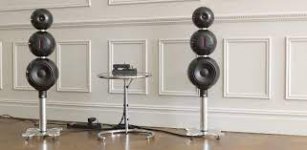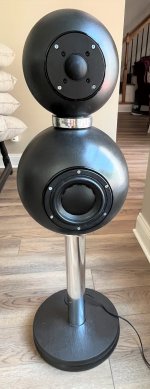The thing you may be alluding to is the varying stiffness as you look around the box, after all the glue that binds the panels is usually quite sufficient compared to the panels themselves. So it's the discontinuities in the shape that concern us even when applying otherwise even pressures in the box. The sphere is relatively good at handling consistent pressure variations.The sphere is one piece while all other enclosures have joined individual panels of some kind.
Yes you're really comparing the structure of the sphere as one shape, and its strength, to the glues ability (and/or other fasteners) to make a box or other shape act as "one piece".
An additional food for thought for Planet10, imagine we're back in 1968/9 (and had internet pretend) and we're all posting about the latest and greatest box speakers (that was essentially all there was) and along comes Amar Bose with the 901 and Walsh/Ohm with his original driver and design? The comments might be "what you mean there ain't no tweeters and all those drivers point backwards" (the 901), or "seriously, listen to the back side of a down firing speaker, huh?" (the Ohm). But that's innovation.
Installing a new Linn, i turned his 901 180° and everything sounded better.listen to the back side
dave
BTW, the first 901s used the same driver the early EPI microTowers used. There are some significant 4” FRs of those days. I aquired my first store bought loudspeakers about that time, they had an 8” RSC FR (with whizzer).
dave
dave
An additional food for thought for Planet10, imagine we're back in 1968/9 (and had internet pretend) and we're all posting about the latest and greatest box speakers (that was essentially all there was) and along comes Amar Bose with the 901 and Walsh/Ohm with his original driver and design? The comments might be "what you mean there ain't no tweeters and all those drivers point backwards" (the 901), or "seriously, listen to the back side of a down firing speaker, huh?" (the Ohm). But that's innovation.
They just reworked their 1966 era model 2201 after it didn't sell enough.
Attachments
So question for Booger weldz, what speakers are your favorite and/or do you listen to now?
Can you post a couple of pics?
Meanwhile mine are posted at the Ikea Hack site, no one from what I can see has ever done this with 4 spheres:
https://ikeahackers.net/2022/06/spherical-speakers-ikea-bowl-hack.html
No spheres… i suck🤓 but maybe after this thread..Figure something out
Attachments
-
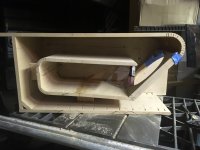 9ADE5FBD-B484-4DD8-8BA0-90ABA4C11DAB.jpeg661.1 KB · Views: 122
9ADE5FBD-B484-4DD8-8BA0-90ABA4C11DAB.jpeg661.1 KB · Views: 122 -
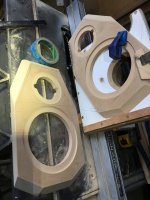 4B1ED858-543C-4EF8-9A0E-FC4C93DCFAC4.jpeg444.5 KB · Views: 126
4B1ED858-543C-4EF8-9A0E-FC4C93DCFAC4.jpeg444.5 KB · Views: 126 -
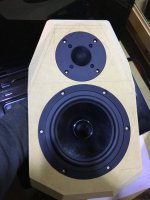 4828A986-0D2B-438E-91F7-9F40FC616D62.jpeg369.2 KB · Views: 113
4828A986-0D2B-438E-91F7-9F40FC616D62.jpeg369.2 KB · Views: 113 -
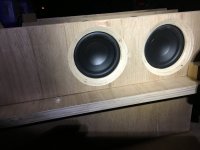 98084BF1-6E43-4BD4-B21E-75B412A10BEC.jpeg378.1 KB · Views: 120
98084BF1-6E43-4BD4-B21E-75B412A10BEC.jpeg378.1 KB · Views: 120 -
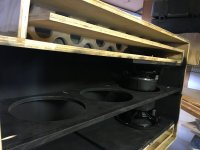 3B2EBDC8-91D5-41EF-B6BF-CBE9E9E3A90D.jpeg315.5 KB · Views: 119
3B2EBDC8-91D5-41EF-B6BF-CBE9E9E3A90D.jpeg315.5 KB · Views: 119 -
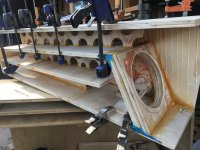 FE4EDC26-0693-4147-BD19-017C7FB0D004.jpeg669 KB · Views: 135
FE4EDC26-0693-4147-BD19-017C7FB0D004.jpeg669 KB · Views: 135
The transmission line is impressive wood working indeed! Question, how much incremental advantage do you forsee vs. alternatives such as more traditional ported enclosures, sealed systems with more drivers, and/or with passive radiators or large subwoofers?
The tweeter shown in the smaller speaker, is that a Dayton?
One of the classy sphere brands from Demand Better Audio is the Envy 3 - which ain't cheap but lots of high tech materials. I made a 2-sphere version with accompanying sub that's not quite as fancy but like the look.
Thx for sharing.
The tweeter shown in the smaller speaker, is that a Dayton?
One of the classy sphere brands from Demand Better Audio is the Envy 3 - which ain't cheap but lots of high tech materials. I made a 2-sphere version with accompanying sub that's not quite as fancy but like the look.
Thx for sharing.
Attachments
So the sphere (so far) is beneficial for the defraction and typical rigidity due to shape?
There’s a guy I ran into a couple times and what are the speaker group things on Facebook and he was always using plastic pipe in his 3-D printer to make offset driver TL full range but specifically around the driver he would put a sphere. It looked really good he was normally a custom lamps and lighting fixture designer and had a little shop and everything but all the tools to make all of these plastic pipe parts look completely not like toilet plumbing or elbows and teasIt looked really good he was normally a custom lamps and lighting fixture designer and had a little shop and everything but all the tools to make all of these plastic pipe parts look completely not like toilet plumbing or elbows and T’s.
The golden ratio in higher orders is no longer so easily comprehended as .618 and 1.618 and 2.618 our first the reciprocal one divided by X and then the square version of that.
as soon as you jump that hula hoop no pun intended as it’s just circles and circles and circles, The number to 618 is also 15° but double that is 30 and it’s 5236 which is pi divided by nine.
And in a 300 cm quarter wave pipe the exact location for driver entry and folding increments if doing so well present math(numbers) directly related to the bigger picture and all of this.
300×0349065(pi/9) Is 104.72cm
10472×3 is pi.
But 349065 as a reciprocal of one over X is 2864782
and the remaining 195.28 inches into 10472 Is 1864782
and 100 cm is 864 Hz and now we have a sequence just like the golden ratio stages up in higher dimensions.
We also have a similar number to the exact speed of light several times 1864782 miles is 186282
300 as 299.792458
5236 as 30 degrees (29.98*)
The swing on a pendulum 100 cm long is exactly 30° and the pendulum is actually the length of 86.4 Hz. That is 50° and the 2618 we started with but the straight line distance between that arc of the pendulum swing is both .25 and fivThat is 50° and the 2618 we started with but the straight line distance between that arc of the pendulum swing is both .25 and 0.5 total.
So you can construct a hexagon that lies directly on top of that circle and moving all the way around the flats versus the points on the hexagon are the locations of P max and pee minimum of an enclosure 360 cm long for the harmonic that sits right inside that.
so we’ve constructed this offset driver transmission line that perfectly and precisely fills the notch that used to be at the top of the band with an extended all the way out to another frequency.
If we take that concept as a 360 cm version instead of 300 and we lay it out it ends up having 300 cm between the drivers instead and 30 off of each end.
when you do that suddenly you notice that every single frequency starting at 864 is gone.
Because you’ve lined up things especially from 01 360 and sent them backwards across the driver entry points to the 150 cm between them or 180 as enclosure size and the exit is put at the two 7090 mark so it’s always in phase and always will be as it keeps rolling out unwrapped.
So it exits the enclosure lined up in that same manner and the Oso driver entry TL version is very similar as they’re both working on the same area however the compounded version or the higher order transmission line doubler or a series version of it both cancel out all these frequencies at 10 and 100 times the frequency which is the little niche mark or evidence of what it was prior to in the fourth order design transmission line by comparison.
all of that mumbo-jumbo which is truly interesting to build a witness because the pressure built up at those ends of the folded cabinet at 90 cm Each in the compounded version or strictly at the 1 0472 and 100 and 95.28 parts Of the standard transmission line type or also the series higher order version which uses the 30 cm again but fools at 1:20 and 240 and then drive her entries again at 270 which is 30 off of the 240 where that upstream section drops and offset and P minimum onto a new P maximumBut since they’re polar opposites it’s a push and pull or a suck and blow action perfectly in sequence.
so all of these higher order cabinets and things that are complicated that nobody wants to really put together deal with because they’re kind of a headache and didn’t used to be something you could iron out in the details or even perceive are now exposed thoroughly in horn response at the same time one has to ponder why the inside of a rectangle which is two to one in every way except for the length as the two is the mathematical version of both a broken up hexagon and it’s pieces rearranged but also withholds the mathPythagorean triangle parts of hypotenuse which describe a circle in parts and by doing so are the bits and pieces of the speed of light in the description uniquely inside Egyptian pyramid already carving solid granite somehow and also repeated as inside that same room is this rectangle that is proportionately identical which apparently had at some point the ark of the covenant in it? Which who knows what the heck that is actually all about but anyone who was guarding it tended it or keep it safe would get cataracts because inside was uranium or something and these things are kind of archaeological in nature but once you dig deeper into archaeology you come up with the same numbers as we commonly know of as these frequencies that are very specific to the number 12 or the numbers already presented in 1÷254 as decimals in inches in increments that are the same.
All of these patterns always keep repeating their describe differently there in different sciences or historically relevant things does it matter when they’re in the sun and the moons dimensions as well as seconds in a day or hours intervals of that split in half or doubled in either direction???
There’s simply something here that’s more important than necessarily missing what might be innocent information let alone whatever version of the best speaker design is everyone who understands speakers should be curious and look at what this first means or shows because it is a baseline data to watch everything else can be compared or presented in a way that starts at the centimeters is the diameter of a drop of water no matter where you are a nurse and a flat dry surface.
And if you look at light as a mirror in the rectangle or in a telescope or microscope then look at sound as the rigid perfect ends of rectangles and then you get the same attributes in superposition and low pass filter gain as it drops into the next full and then another in those steps at which are prescribed by these funny little mask works like pi divided by three or two and six and nine?
And what those are in degrees or centimeters in circumference of a circle can be implemented into rectangle chunks and then there’s this funny alignment that creates a few attributes that include the actual pumping sequence of the driver from both or either closed end or the extension of things that are complementing each other and still maintaining a phase her relationship higher up in frequencies or the fact that you can take that seam off the driver entry that’s extended upwards it’s the bandwidth and you can Maslows the last segment with the reduction and have the widest bandwidth possible andBass reflex issue supports that compress or get noisy or got to be polished up and shiny and stuff as well as the fact that a phase inversion at the bottom end doesn’t provide any math or numbers or things that relate to much much more important and bigger concepts already??
and then of course there’s all the other details like this scare shaped fruit and diffraction that opens up another can of worms but is this food on the inside that matters? Because the pressure at the P max at the end of even my crash test dummy little models of these things is insane when it’s always appropriate from both sides of the driver it’s not diluted or fizzled out in multiple foods that are not in agreement with the same wave shape already where it crosses the X axis or peak amplitude and vice versa as the reflection or cosign it all agrees it’s all lined up it’s gotta be perfect but it’s not very hard it seems.
But when I do this with this lineup suddenly the mouth and opening wear the short path and the long path conversion really quickly at what is also the exit straight out of the long path or play with which side gets the actual exit or just let them both come out together it is truly unique what happens in that area and playing Testaments that happened to police the node right there as well or doesn’t.
or playing test does that fit in the folding that you did in the strange ways that the offset driver transition line can be forced into it and arrangement that has very brief rear chamber that’s only used to reinforce the pressure of the back to not minimize its connection to the front at the exit that end well almost all of this is specific to subwoofer it does point out some incredibly important things that may or may not make people want to fold up enclosures into the snakes mazes, They need to be at a note in anti-node or you’re losing out on what transmission line was supposed to be about and already.
Kinda like if you take the Bose wave cannon and you draw a sine wave on it that perfectly crosses with the driver mounts but in the 90 cm to the end or the 270 to the other end you have three shapes that are a third of a circle unwrapped a sideways and if you cut each of those 90 parts into 30s and dry diagonals you see this pipe peace thing going all around that’s a hexagon and that matters to all of this and just like 30° doesn’t trigonometry on the unit circle it’s extremely useful as is 22 five and 45 as well two different disciplines Calculating the torque on the connecting rod relationship to the crankshaft or the spark at a certain RPM and when obviously not a top dead center you’re gonna drop that hammer onto the piston.
Increasing the bed which is like increasing the RPM that you get to use or variable valve timing on an engine I guess today’s modern version of what exists in electrical motors at start up when their AC resistors in line in the beginning and then they come off line is RPMs come up?
things all together are valuable not just for bed with extension but for a whole lot of other things in the details it seems.
And of course it’s convenient to see you look something up and forget about it or to this base reflects it because it’s quick and it works fine too. But there actually is more to it regardless and some of that is just interesting science and numbers and things that you run into but at the end of the day it may pan out into a much grander more important parts of all of this as well?
I don’t know and I don’t even have a very well-established acoustical engineering or electronica or anything background that would allow me to even share things that were fair and made sense. It’s more of a sawdust and horn response thing and something that suddenly sparked an interest because the numbers ended up being similar to numbers that are in atomic mass units are very important things as well and those things end up being associated with the speed of light or are the decay daughters of the uranium in fission as well. You have 235 as a location of Mars you have 235 as the peak after the peak at the end of bandwidth in these high order enclosure in parallel already and prior to that the peak is at 149.6 Hz which happens to be the 31496 in 80÷254 but if you build the enclosure using 80 cm increments I end up with a tutti-frutti see iYou have 235 as a location of Mars you have 235 as the peak after the peak at the end of bandwidth in these high order enclosure in parallel already and prior to that the peak is at 149.6 Hz which happens to be the 31496 in 80÷254 but if you build the enclosure using 80 cm increments I end up with a tuning fb at 39.37 hz which is the 10÷254….
Versions of pi shifted in another set of numbers and nobody looks at because they’re deep in decimal points but the pendulum swing for 86.4 Hz is 39.37 inches or 100 cm. It’s all kinds of numbers and connections to things in both fourth sixth and eighth order.
You can arrange Qw resonators and all of them to produce these things. And it changes from one type to the other but each one of them is unique in the information they revealed when it’s lined up to cancel out perfectly out of band what is gigantically promoting in band and there’s a relationship they’re not unlike quantum entanglement whatever the heck that is or duality in particles and waves briefly seen here in a logarithmic sharing a 10 and 100.
Reality 10 and 100 are approximately 96 at 9.6, Saturn is 9.58 on earth which is one astronomical unit. Saturn is also at 864 xxxx miles from the sun, What is at 93312 and change which is half the speed of light of 1864624… what number is 432 squared and when we jump onto the Pythagorean theorem wagon we see what 864 and 1728 do and how they arrive at 1496 as well.
There’s a guy I ran into a couple times and what are the speaker group things on Facebook and he was always using plastic pipe in his 3-D printer to make offset driver TL full range but specifically around the driver he would put a sphere. It looked really good he was normally a custom lamps and lighting fixture designer and had a little shop and everything but all the tools to make all of these plastic pipe parts look completely not like toilet plumbing or elbows and teasIt looked really good he was normally a custom lamps and lighting fixture designer and had a little shop and everything but all the tools to make all of these plastic pipe parts look completely not like toilet plumbing or elbows and T’s.
everything is a value and has attributes in so many ways it all encompasses so many things that are far more interesting if somehow you step over to the other side of what’s being represented??The transmission line is impressive wood working indeed! Question, how much incremental advantage do you forsee vs. alternatives such as more traditional ported enclosures, sealed systems with more drivers, and/or with passive radiators or large subwoofers?
The tweeter shown in the smaller speaker, is that a Dayton?
One of the classy sphere brands from Demand Better Audio is the Envy 3 - which ain't cheap but lots of high tech materials. I made a 2-sphere version with accompanying sub that's not quite as fancy but like the look.
Thx for sharing.
The golden ratio in higher orders is no longer so easily comprehended as .618 and 1.618 and 2.618 our first the reciprocal one divided by X and then the square version of that.
as soon as you jump that hula hoop no pun intended as it’s just circles and circles and circles, The number to 618 is also 15° but double that is 30 and it’s 5236 which is pi divided by nine.
And in a 300 cm quarter wave pipe the exact location for driver entry and folding increments if doing so well present math(numbers) directly related to the bigger picture and all of this.
300×0349065(pi/9) Is 104.72cm
10472×3 is pi.
But 349065 as a reciprocal of one over X is 2864782
and the remaining 195.28 inches into 10472 Is 1864782
and 100 cm is 864 Hz and now we have a sequence just like the golden ratio stages up in higher dimensions.
We also have a similar number to the exact speed of light several times 1864782 miles is 186282
300 as 299.792458
5236 as 30 degrees (29.98*)
The swing on a pendulum 100 cm long is exactly 30° and the pendulum is actually the length of 86.4 Hz. That is 50° and the 2618 we started with but the straight line distance between that arc of the pendulum swing is both .25 and fivThat is 50° and the 2618 we started with but the straight line distance between that arc of the pendulum swing is both .25 and 0.5 total.
So you can construct a hexagon that lies directly on top of that circle and moving all the way around the flats versus the points on the hexagon are the locations of P max and pee minimum of an enclosure 360 cm long for the harmonic that sits right inside that.
so we’ve constructed this offset driver transmission line that perfectly and precisely fills the notch that used to be at the top of the band with an extended all the way out to another frequency.
If we take that concept as a 360 cm version instead of 300 and we lay it out it ends up having 300 cm between the drivers instead and 30 off of each end.
when you do that suddenly you notice that every single frequency starting at 864 is gone.
Because you’ve lined up things especially from 01 360 and sent them backwards across the driver entry points to the 150 cm between them or 180 as enclosure size and the exit is put at the two 7090 mark so it’s always in phase and always will be as it keeps rolling out unwrapped.
So it exits the enclosure lined up in that same manner and the Oso driver entry TL version is very similar as they’re both working on the same area however the compounded version or the higher order transmission line doubler or a series version of it both cancel out all these frequencies at 10 and 100 times the frequency which is the little niche mark or evidence of what it was prior to in the fourth order design transmission line by comparison.
all of that mumbo-jumbo which is truly interesting to build a witness because the pressure built up at those ends of the folded cabinet at 90 cm Each in the compounded version or strictly at the 1 0472 and 100 and 95.28 parts Of the standard transmission line type or also the series higher order version which uses the 30 cm again but fools at 1:20 and 240 and then drive her entries again at 270 which is 30 off of the 240 where that upstream section drops and offset and P minimum onto a new P maximumBut since they’re polar opposites it’s a push and pull or a suck and blow action perfectly in sequence.
so all of these higher order cabinets and things that are complicated that nobody wants to really put together deal with because they’re kind of a headache and didn’t used to be something you could iron out in the details or even perceive are now exposed thoroughly in horn response at the same time one has to ponder why the inside of a rectangle which is two to one in every way except for the length as the two is the mathematical version of both a broken up hexagon and it’s pieces rearranged but also withholds the mathPythagorean triangle parts of hypotenuse which describe a circle in parts and by doing so are the bits and pieces of the speed of light in the description uniquely inside Egyptian pyramid already carving solid granite somehow and also repeated as inside that same room is this rectangle that is proportionately identical which apparently had at some point the ark of the covenant in it? Which who knows what the heck that is actually all about but anyone who was guarding it tended it or keep it safe would get cataracts because inside was uranium or something and these things are kind of archaeological in nature but once you dig deeper into archaeology you come up with the same numbers as we commonly know of as these frequencies that are very specific to the number 12 or the numbers already presented in 1÷254 as decimals in inches in increments that are the same.
All of these patterns always keep repeating their describe differently there in different sciences or historically relevant things does it matter when they’re in the sun and the moons dimensions as well as seconds in a day or hours intervals of that split in half or doubled in either direction???
There’s simply something here that’s more important than necessarily missing what might be innocent information let alone whatever version of the best speaker design is everyone who understands speakers should be curious and look at what this first means or shows because it is a baseline data to watch everything else can be compared or presented in a way that starts at the centimeters is the diameter of a drop of water no matter where you are a nurse and a flat dry surface.
And if you look at light as a mirror in the rectangle or in a telescope or microscope then look at sound as the rigid perfect ends of rectangles and then you get the same attributes in superposition and low pass filter gain as it drops into the next full and then another in those steps at which are prescribed by these funny little mask works like pi divided by three or two and six and nine?
And what those are in degrees or centimeters in circumference of a circle can be implemented into rectangle chunks and then there’s this funny alignment that creates a few attributes that include the actual pumping sequence of the driver from both or either closed end or the extension of things that are complementing each other and still maintaining a phase her relationship higher up in frequencies or the fact that you can take that seam off the driver entry that’s extended upwards it’s the bandwidth and you can Maslows the last segment with the reduction and have the widest bandwidth possible andBass reflex issue supports that compress or get noisy or got to be polished up and shiny and stuff as well as the fact that a phase inversion at the bottom end doesn’t provide any math or numbers or things that relate to much much more important and bigger concepts already??
and then of course there’s all the other details like this scare shaped fruit and diffraction that opens up another can of worms but is this food on the inside that matters? Because the pressure at the P max at the end of even my crash test dummy little models of these things is insane when it’s always appropriate from both sides of the driver it’s not diluted or fizzled out in multiple foods that are not in agreement with the same wave shape already where it crosses the X axis or peak amplitude and vice versa as the reflection or cosign it all agrees it’s all lined up it’s gotta be perfect but it’s not very hard it seems.
But when I do this with this lineup suddenly the mouth and opening wear the short path and the long path conversion really quickly at what is also the exit straight out of the long path or play with which side gets the actual exit or just let them both come out together it is truly unique what happens in that area and playing Testaments that happened to police the node right there as well or doesn’t.
or playing test does that fit in the folding that you did in the strange ways that the offset driver transition line can be forced into it and arrangement that has very brief rear chamber that’s only used to reinforce the pressure of the back to not minimize its connection to the front at the exit that end well almost all of this is specific to subwoofer it does point out some incredibly important things that may or may not make people want to fold up enclosures into the snakes mazes, They need to be at a note in anti-node or you’re losing out on what transmission line was supposed to be about and already.
Kinda like if you take the Bose wave cannon and you draw a sine wave on it that perfectly crosses with the driver mounts but in the 90 cm to the end or the 270 to the other end you have three shapes that are a third of a circle unwrapped a sideways and if you cut each of those 90 parts into 30s and dry diagonals you see this pipe peace thing going all around that’s a hexagon and that matters to all of this and just like 30° doesn’t trigonometry on the unit circle it’s extremely useful as is 22 five and 45 as well two different disciplines Calculating the torque on the connecting rod relationship to the crankshaft or the spark at a certain RPM and when obviously not a top dead center you’re gonna drop that hammer onto the piston.
Increasing the bed which is like increasing the RPM that you get to use or variable valve timing on an engine I guess today’s modern version of what exists in electrical motors at start up when their AC resistors in line in the beginning and then they come off line is RPMs come up?
things all together are valuable not just for bed with extension but for a whole lot of other things in the details it seems.
And of course it’s convenient to see you look something up and forget about it or to this base reflects it because it’s quick and it works fine too. But there actually is more to it regardless and some of that is just interesting science and numbers and things that you run into but at the end of the day it may pan out into a much grander more important parts of all of this as well?
I don’t know and I don’t even have a very well-established acoustical engineering or electronica or anything background that would allow me to even share things that were fair and made sense. It’s more of a sawdust and horn response thing and something that suddenly sparked an interest because the numbers ended up being similar to numbers that are in atomic mass units are very important things as well and those things end up being associated with the speed of light or are the decay daughters of the uranium in fission as well. You have 235 as a location of Mars you have 235 as the peak after the peak at the end of bandwidth in these high order enclosure in parallel already and prior to that the peak is at 149.6 Hz which happens to be the 31496 in 80÷254 but if you build the enclosure using 80 cm increments I end up with a tutti-frutti see iYou have 235 as a location of Mars you have 235 as the peak after the peak at the end of bandwidth in these high order enclosure in parallel already and prior to that the peak is at 149.6 Hz which happens to be the 31496 in 80÷254 but if you build the enclosure using 80 cm increments I end up with a tuning fb at 39.37 hz which is the 10÷254….
Versions of pi shifted in another set of numbers and nobody looks at because they’re deep in decimal points but the pendulum swing for 86.4 Hz is 39.37 inches or 100 cm. It’s all kinds of numbers and connections to things in both fourth sixth and eighth order.
You can arrange Qw resonators and all of them to produce these things. And it changes from one type to the other but each one of them is unique in the information they revealed when it’s lined up to cancel out perfectly out of band what is gigantically promoting in band and there’s a relationship they’re not unlike quantum entanglement whatever the heck that is or duality in particles and waves briefly seen here in a logarithmic sharing a 10 and 100.
Reality 10 and 100 are approximately 96 at 9.6, Saturn is 9.58 on earth which is one astronomical unit. Saturn is also at 864 xxxx miles from the sun, What is at 93312 and change which is half the speed of light of 1864624… what number is 432 squared and when we jump onto the Pythagorean theorem wagon we see what 864 and 1728 do and how they arrive at 1496 as well.
A pulsating sphere that would radiate sound equally in all directions sounds nice in theory. And it would in a non reflective environment, but those are hard to find.
For a reflective environment, you want straight FR on axis, but a down sloping power response. Logic dictates that this cannot be achieved with a pulsating sphere.
For a reflective environment, you want straight FR on axis, but a down sloping power response. Logic dictates that this cannot be achieved with a pulsating sphere.
"For a reflective environment, you want straight FR on axis, but a down sloping power response" - why a sloping PR?
//
//
For Mr. Weldz, if I walked into your speaker shop and was interested in buying a pair of the TL speakers you're making, and perhaps without the too much of the math, what would be the 30 second (or 60 second) "elevator pitch" on why they sound better? For example (making this up), on the 1812 Overture with the wonderful cannons at the end, nothing in the world will sound more realistic....etc...
Actually we do have pulsating spheres, just 1/2 spheres as dome tweeters and mids (depending on the curvature of the dome diaphragm). I have used a 5-1/2" Dynavox LW5004PMR-N poly/mica cone mid-woofer, with a 3" coil (no less). So much of the midrange is coming off of the 3" dome part of the diaphragm (prob. down I guess to about 250 HZ) and then the rest down to 100Hz is being assisted by the 1/2" or so outer portion of the diaphragm that serves as a small and shallow cone portion. The driver rolls off below 100Hz. So needs a sub for deep bass. The 3" coil makes it a bit less efficient at about 86 db.
But this minimizes the diffraction that can occur in a deeper cone - as any cone acts as a megaphone that changes the tonality of what come through it by altering the harmonics. The effect off cupping your hands around your mouth while speaking or singing, this especially making a difference in the mids where our ears are most sensitive. The mids on this driver are quite smooth, nice dispersion and no shrillness. The driver itself has little opportunity for diffraction, and then mounted in a sphere for baffling. Or maybe the 12-isided "balls" that have been made with 2-3" drivers is a close enough approximation? But these ain't cheap or easy to make either.
I would think someone could make a complete sphere with a "multidirectional" motor (actually a grouping of magnets/multiple coils in it moving the sphere at equidistant points). With the right material for the sphere diaphragm (rigid yet somewhat elastic) it could pulse, and if enough surface area generate lower frequencies and be of course no baffle.
If we have advanced rovers on Mars, just maybe...?
To me, once you have speakers with drivers that have been primarily in boxes (and more directional in general) as we have had over many decades, and there have been many with very good specs and characteristics, the next frontier has been to try and recreate some of the specialness you get from being in an auditorium listening to a orchestra or jazz ensemble, etc. in your listening room at home. (Of course you can do some of this physically and electronically with multiple speakers and surround sound).
So the 901s and Ohms of the world - and some others after - have sought to do this. And the sound is very different, more open, sometimes better imaging and in the case of really good attempts, the speakers seem to "disappear". But these are also affected by the room characteristics just as there are good and not-so-good auditoriums. But I feel a slightly less than ideal set of drivers and crossovers with an open sound can beat - in the psychoacoustics - the best combinations in a box enclosure.
Actually we do have pulsating spheres, just 1/2 spheres as dome tweeters and mids (depending on the curvature of the dome diaphragm). I have used a 5-1/2" Dynavox LW5004PMR-N poly/mica cone mid-woofer, with a 3" coil (no less). So much of the midrange is coming off of the 3" dome part of the diaphragm (prob. down I guess to about 250 HZ) and then the rest down to 100Hz is being assisted by the 1/2" or so outer portion of the diaphragm that serves as a small and shallow cone portion. The driver rolls off below 100Hz. So needs a sub for deep bass. The 3" coil makes it a bit less efficient at about 86 db.
But this minimizes the diffraction that can occur in a deeper cone - as any cone acts as a megaphone that changes the tonality of what come through it by altering the harmonics. The effect off cupping your hands around your mouth while speaking or singing, this especially making a difference in the mids where our ears are most sensitive. The mids on this driver are quite smooth, nice dispersion and no shrillness. The driver itself has little opportunity for diffraction, and then mounted in a sphere for baffling. Or maybe the 12-isided "balls" that have been made with 2-3" drivers is a close enough approximation? But these ain't cheap or easy to make either.
I would think someone could make a complete sphere with a "multidirectional" motor (actually a grouping of magnets/multiple coils in it moving the sphere at equidistant points). With the right material for the sphere diaphragm (rigid yet somewhat elastic) it could pulse, and if enough surface area generate lower frequencies and be of course no baffle.
If we have advanced rovers on Mars, just maybe...?
To me, once you have speakers with drivers that have been primarily in boxes (and more directional in general) as we have had over many decades, and there have been many with very good specs and characteristics, the next frontier has been to try and recreate some of the specialness you get from being in an auditorium listening to a orchestra or jazz ensemble, etc. in your listening room at home. (Of course you can do some of this physically and electronically with multiple speakers and surround sound).
So the 901s and Ohms of the world - and some others after - have sought to do this. And the sound is very different, more open, sometimes better imaging and in the case of really good attempts, the speakers seem to "disappear". But these are also affected by the room characteristics just as there are good and not-so-good auditoriums. But I feel a slightly less than ideal set of drivers and crossovers with an open sound can beat - in the psychoacoustics - the best combinations in a box enclosure.
A pulsating sphere that would radiate sound equally in all directions sounds nice in theory.
A 4D sphere radiating into 3-space.
dave
Read Toole, Olive, or peruse the JBL site. A speaker with a flat power response sounds overly bright in a reflective environment. You could also do some reading into the Haas effect. Reflected sound impacts on perceived timbre."For a reflective environment, you want straight FR on axis, but a down sloping power response" - why a sloping PR?
//
Another interesting vid by the chief speaker designer at PS Audio about human hearing and whether physical phase / time alignment works (or not) relative to what we can hear.
And one that argues electronic phase shift in speakers (from xovers and amps) is not really audible other than in anechoic chambers - with all the reflections in typical listening rooms. Essentially you get "phase soup" but fortunately the human ear is not sensitive to sound differences below about 40 milliseconds.
And one that argues electronic phase shift in speakers (from xovers and amps) is not really audible other than in anechoic chambers - with all the reflections in typical listening rooms. Essentially you get "phase soup" but fortunately the human ear is not sensitive to sound differences below about 40 milliseconds.
Last edited:
An alternative is to build a sphere speaker for mids and mount it on a conventional box for the bass... sort of like the B&W 800 series. Alternatively if you wish to maintain the roundish look maybe a woofer in a PVC tube. Like what Linkwitz has done lxmini
- Home
- Loudspeakers
- Multi-Way
- How to build a spherical speaker?
